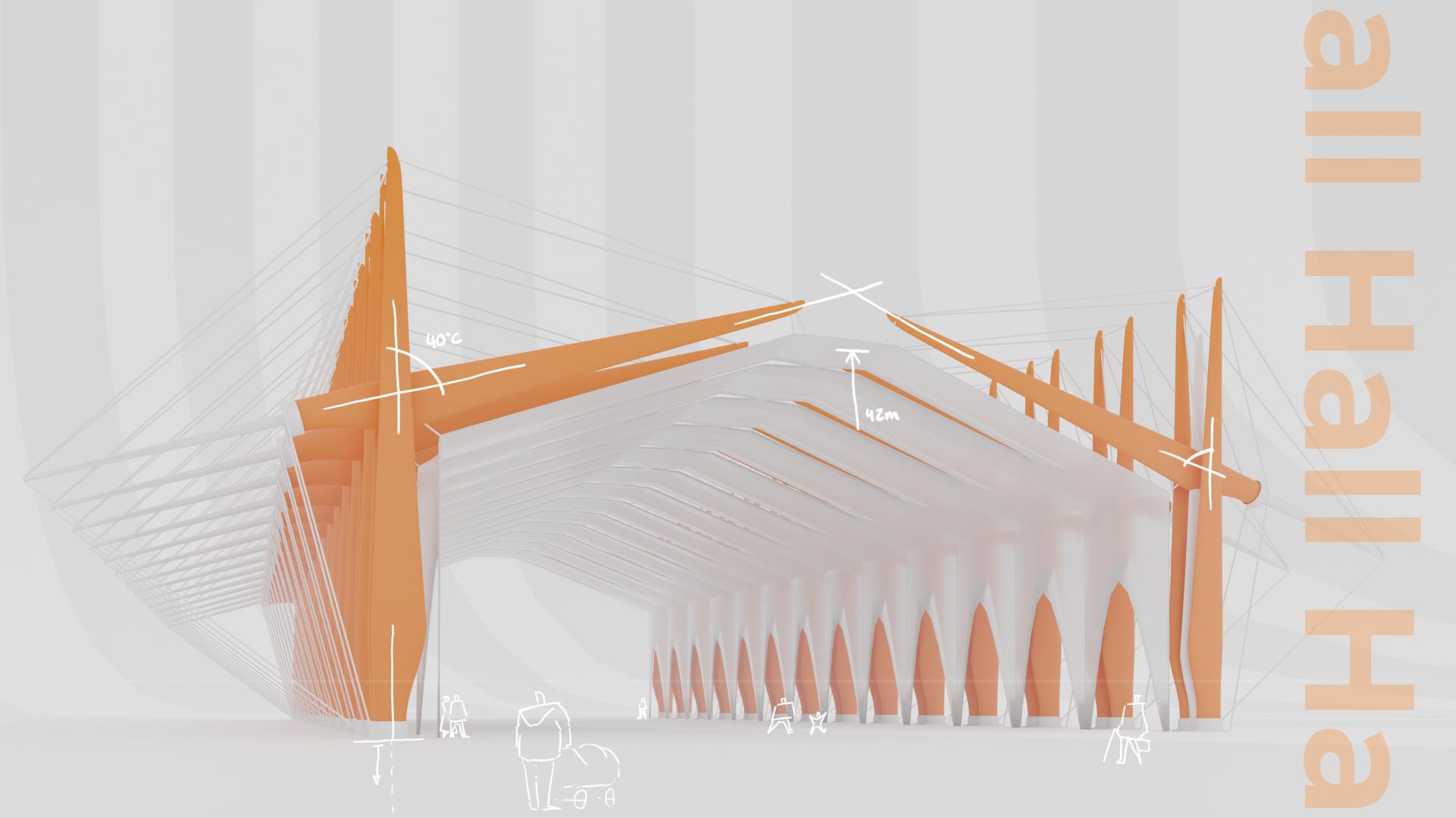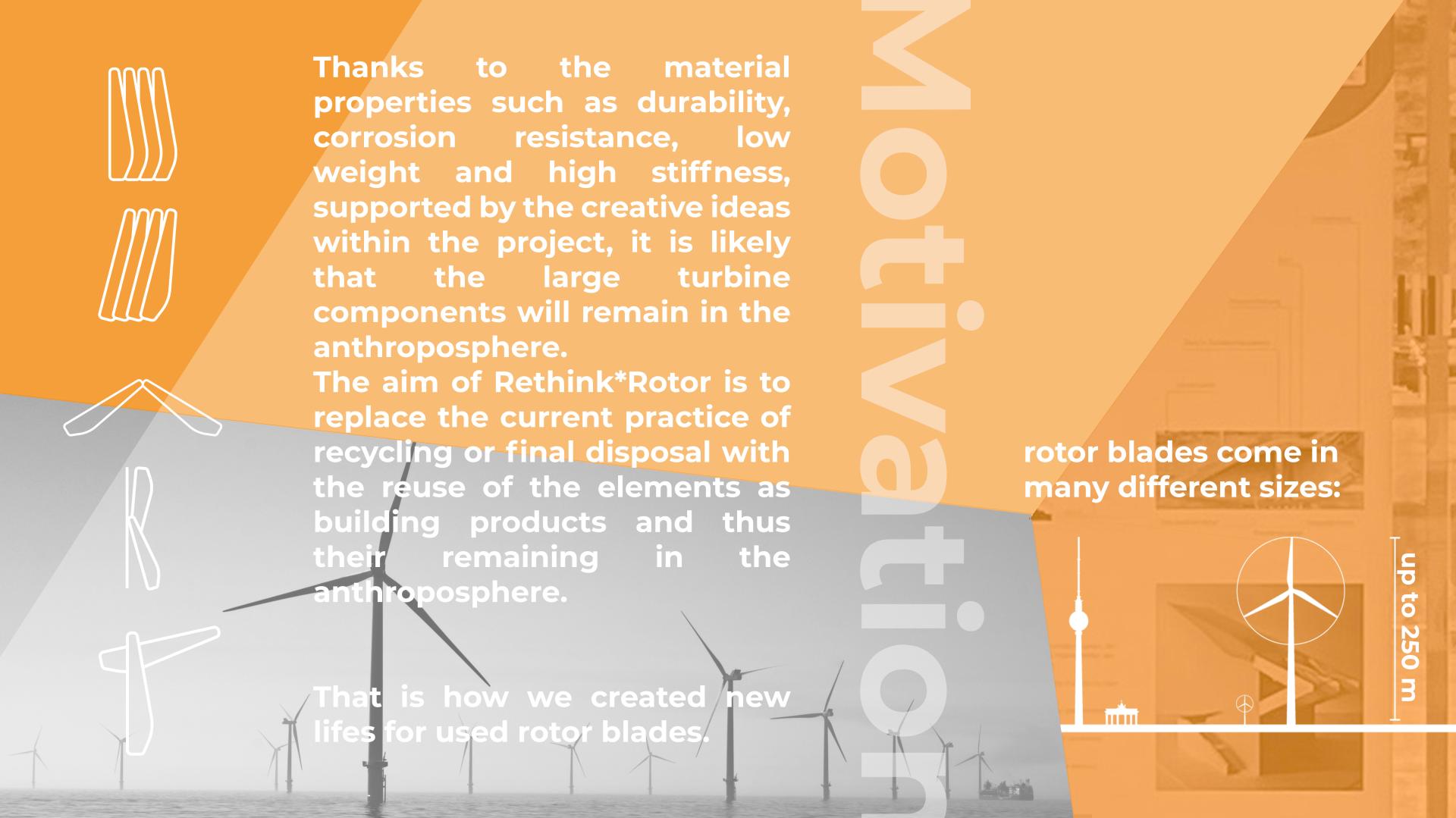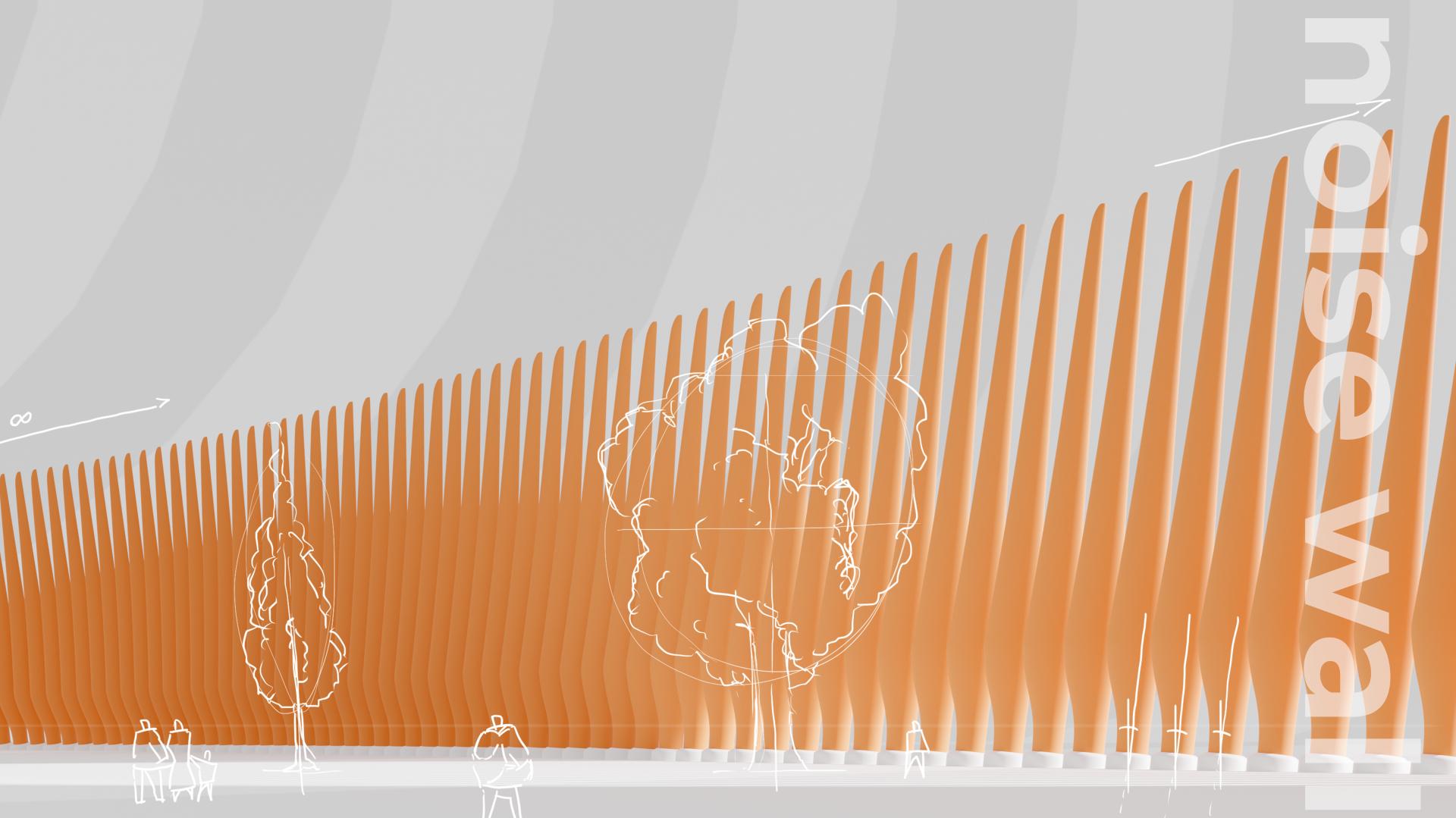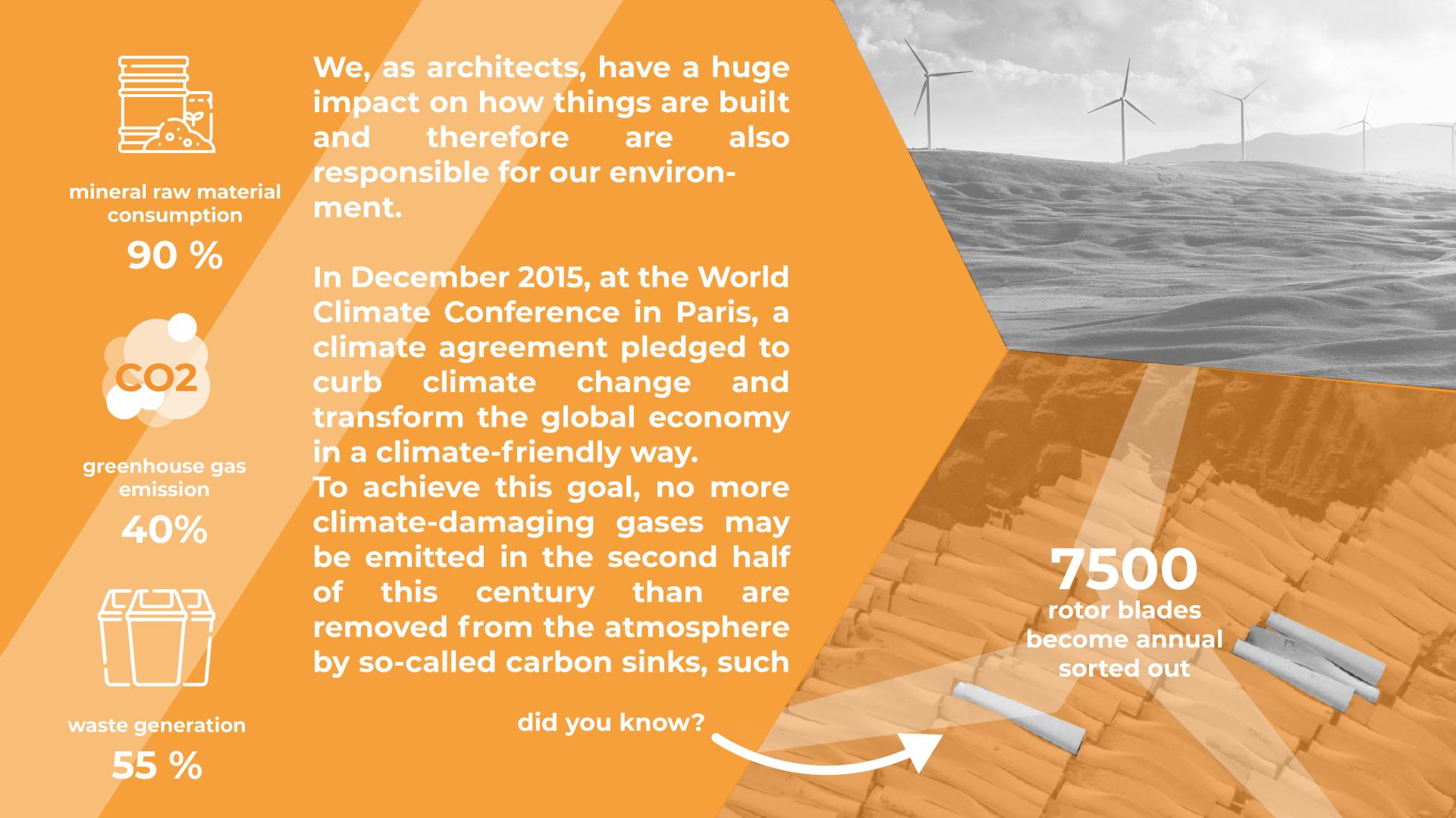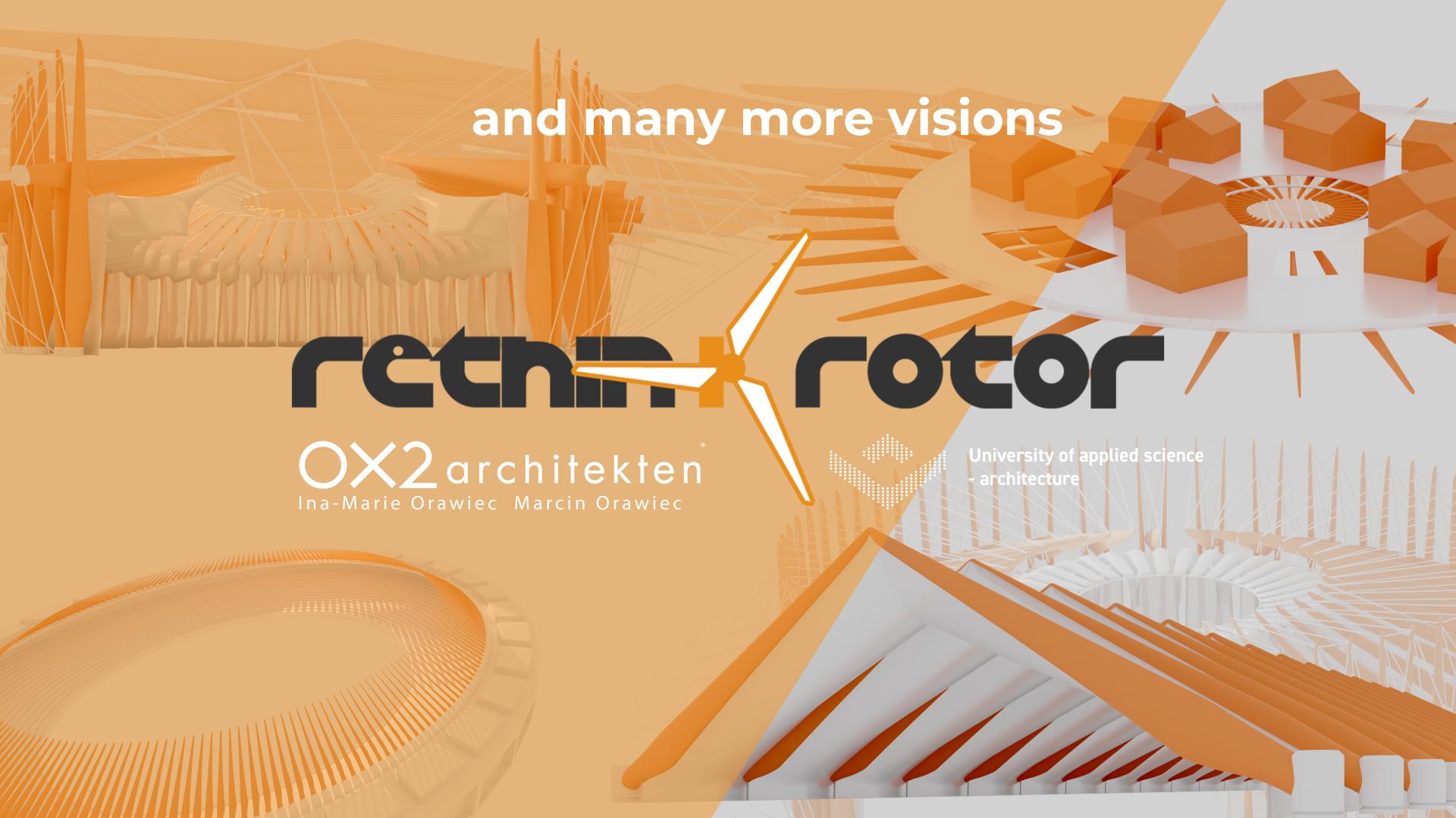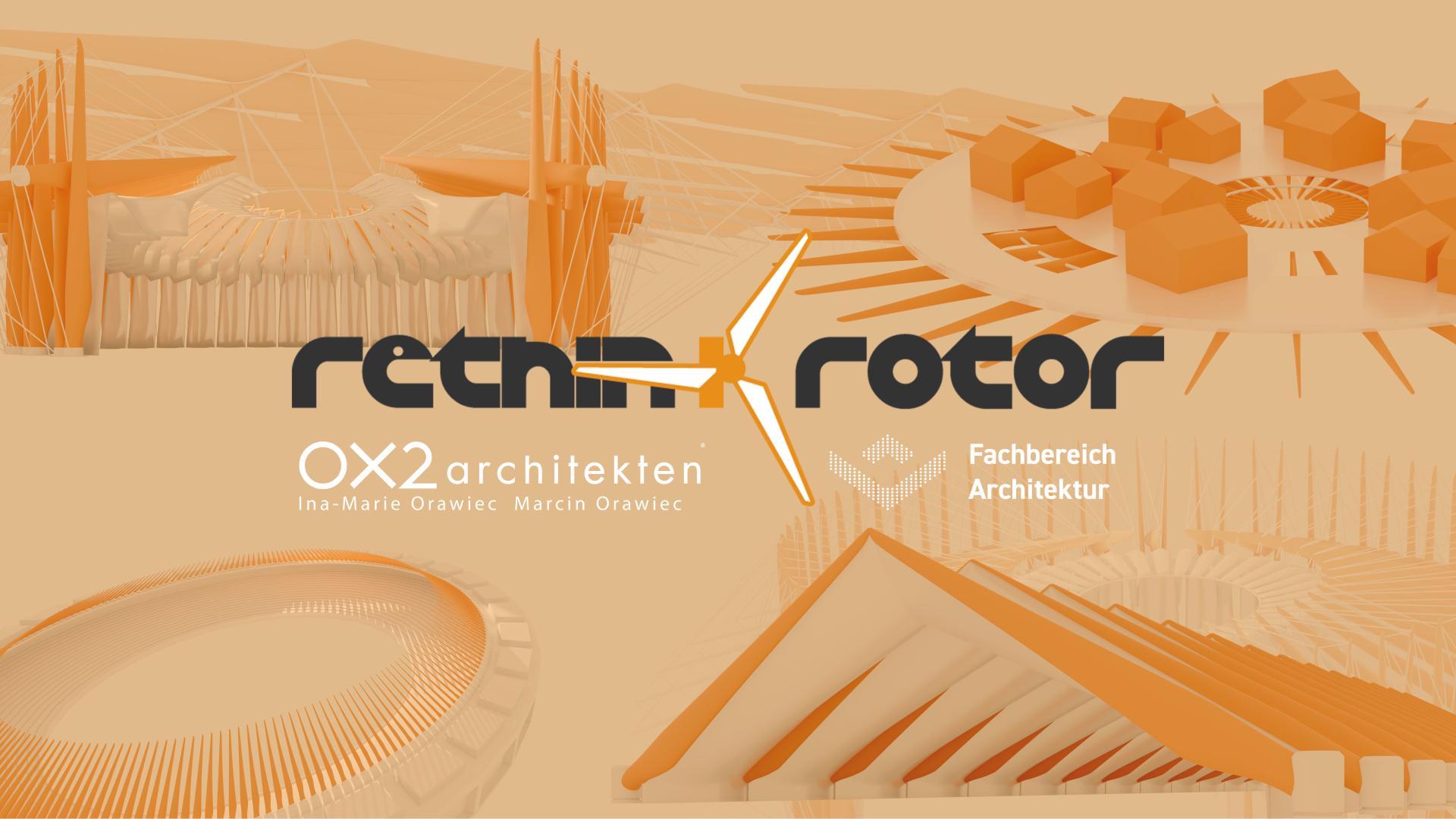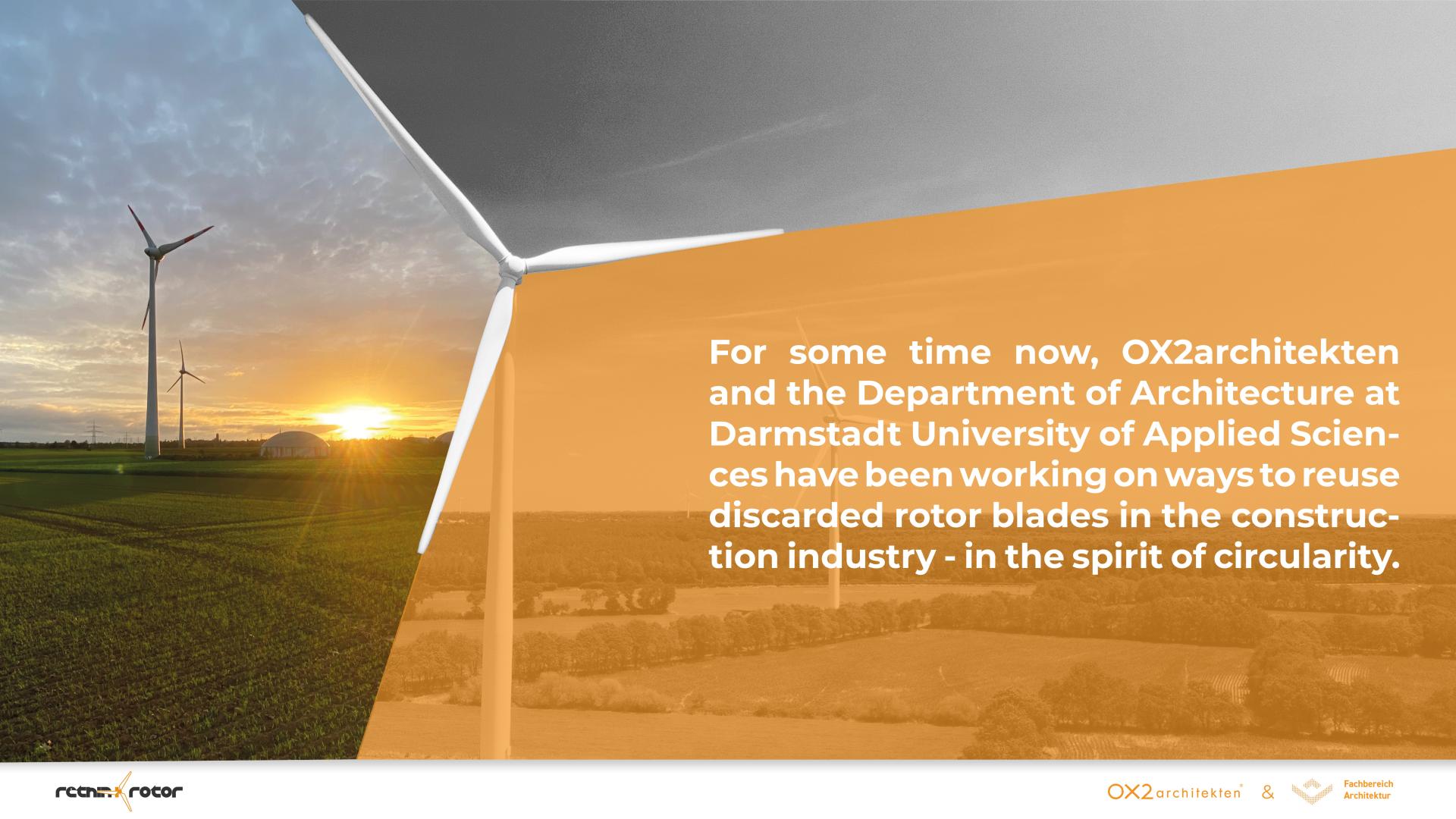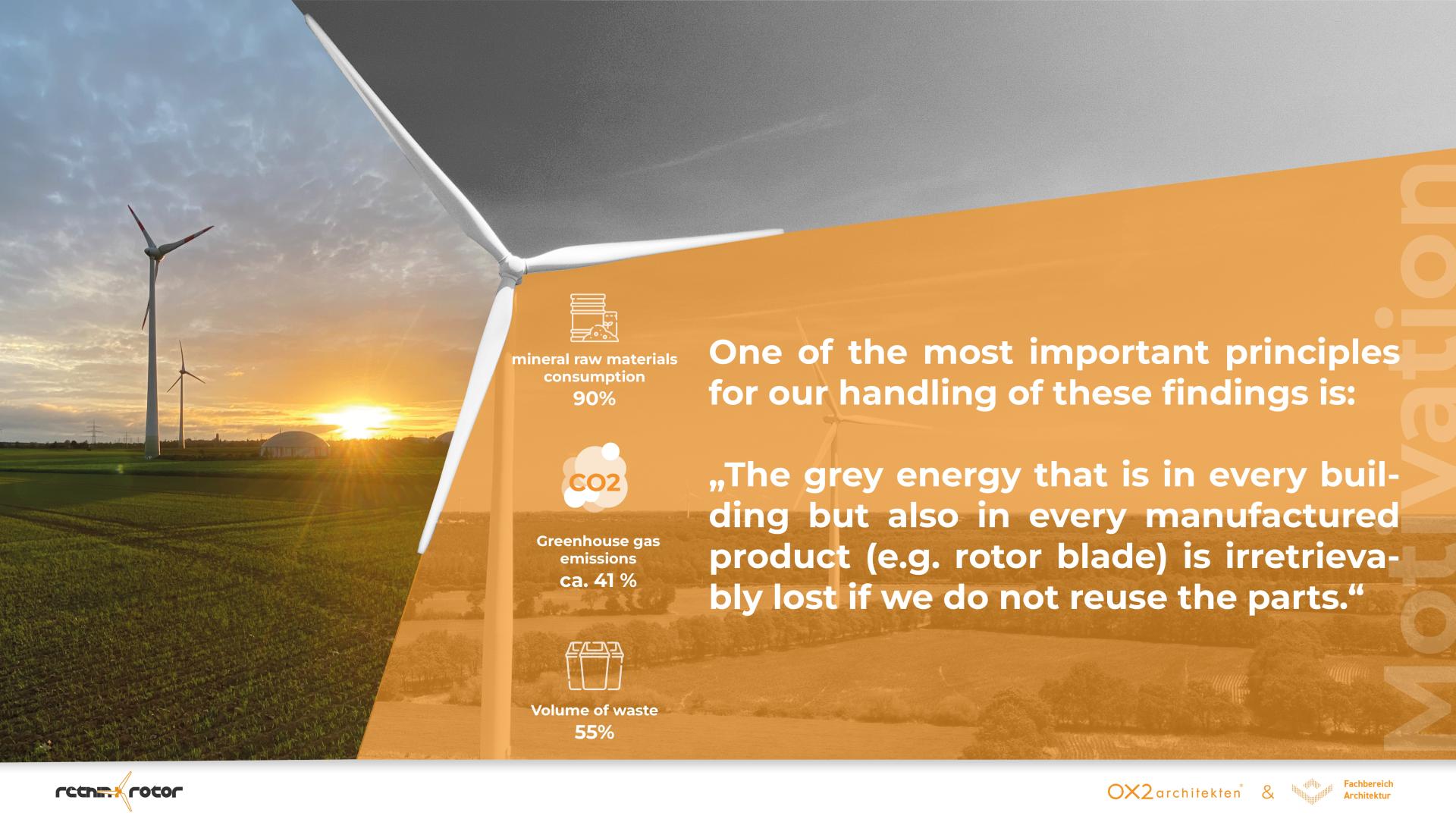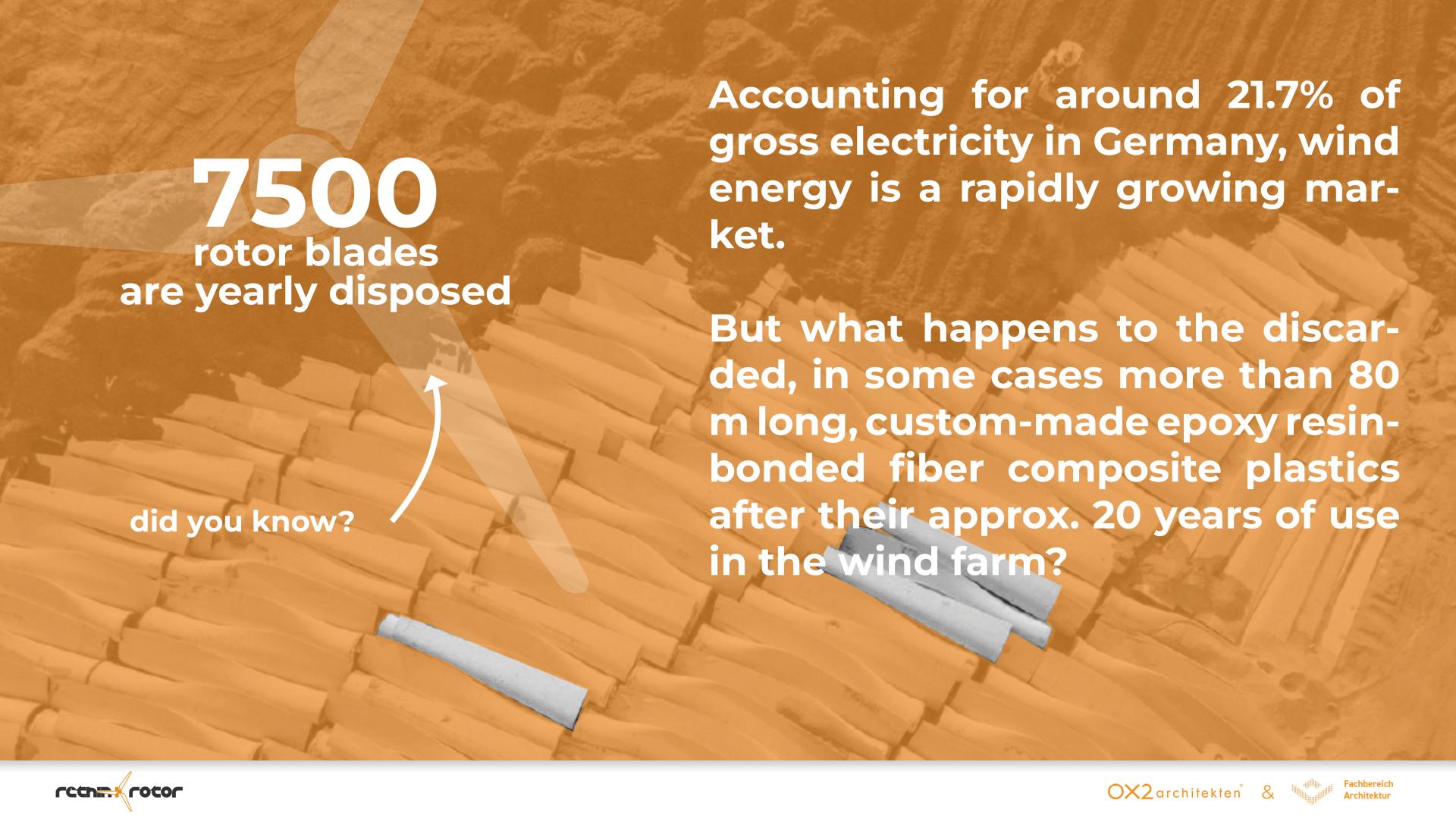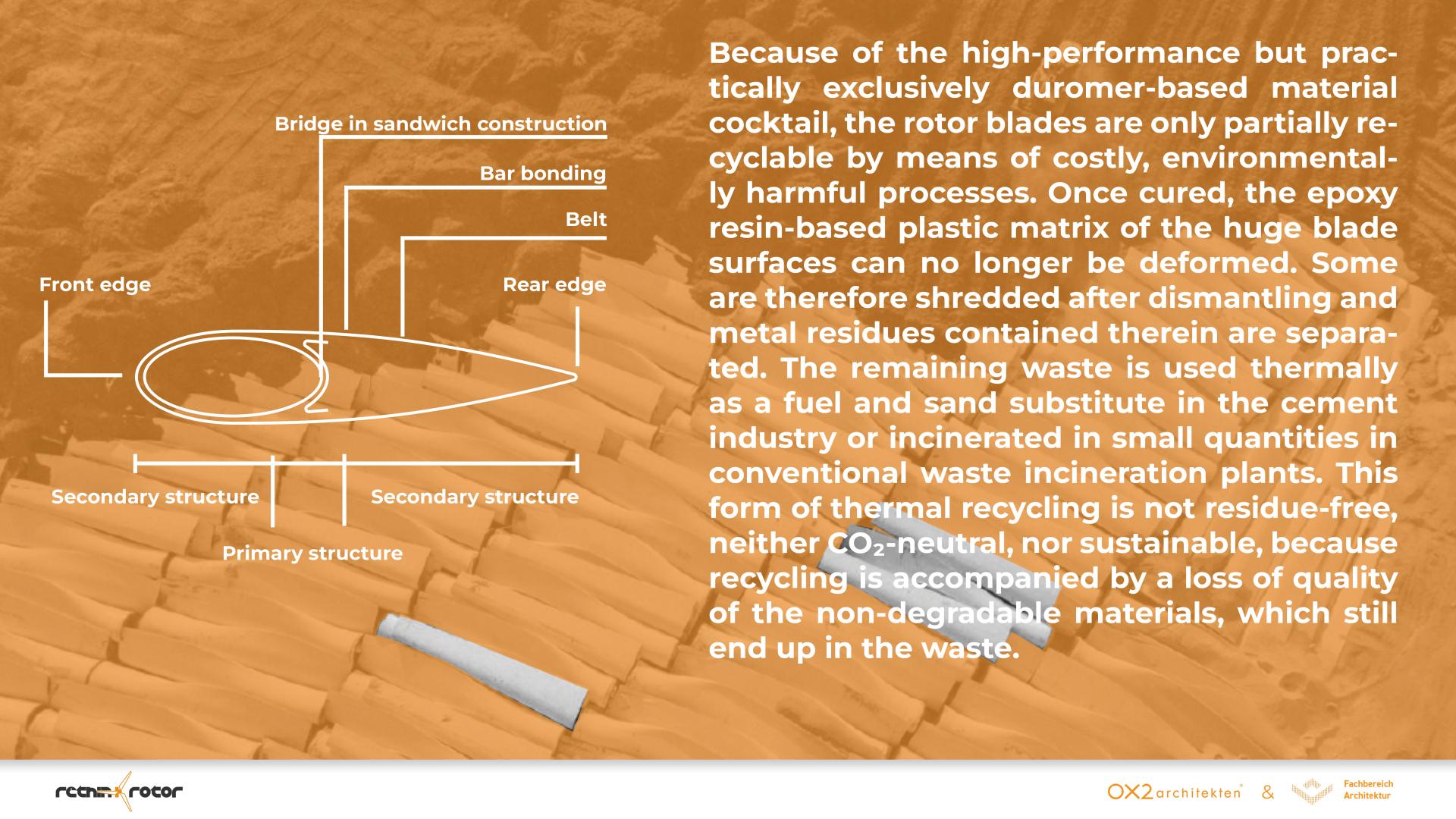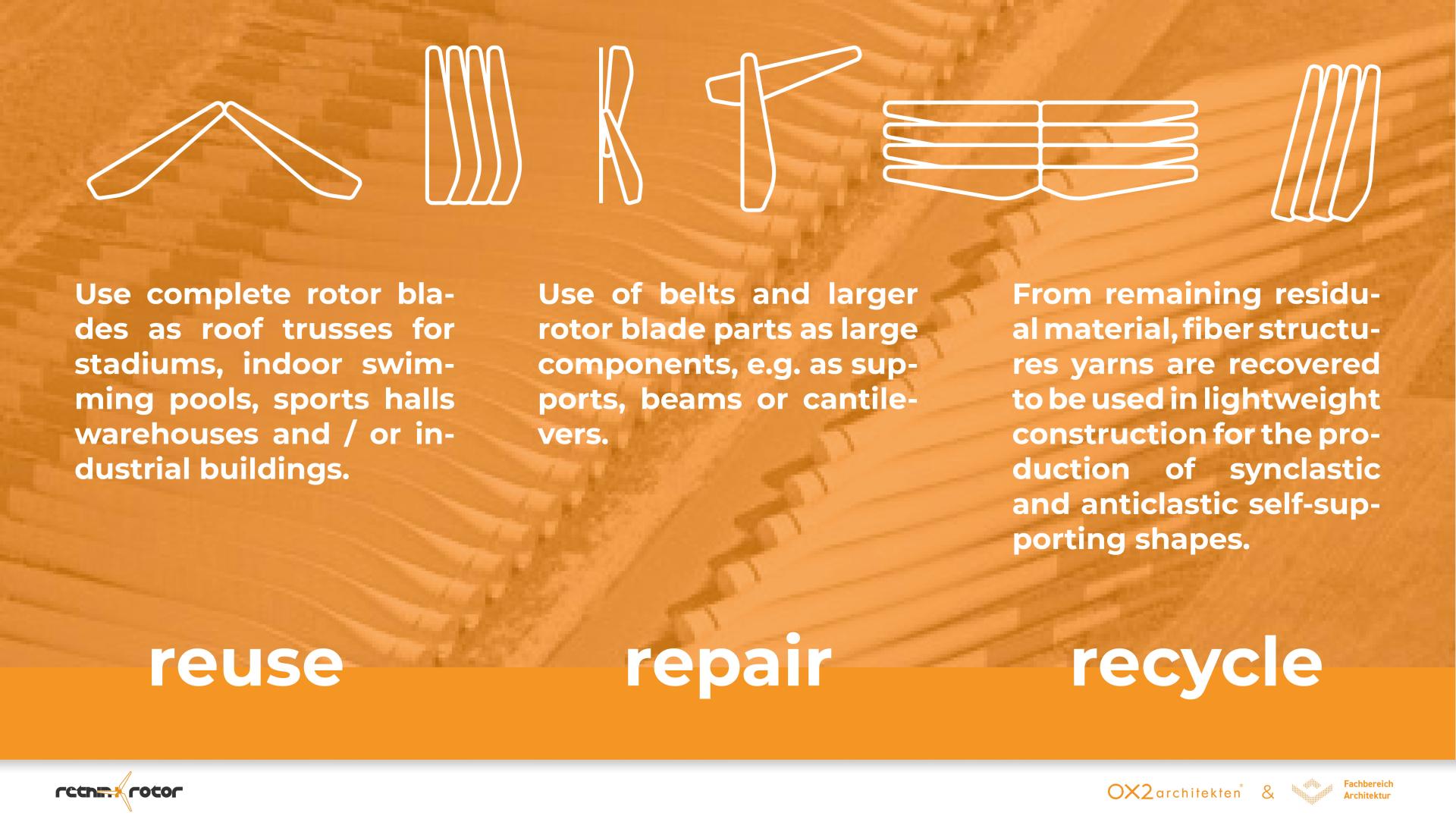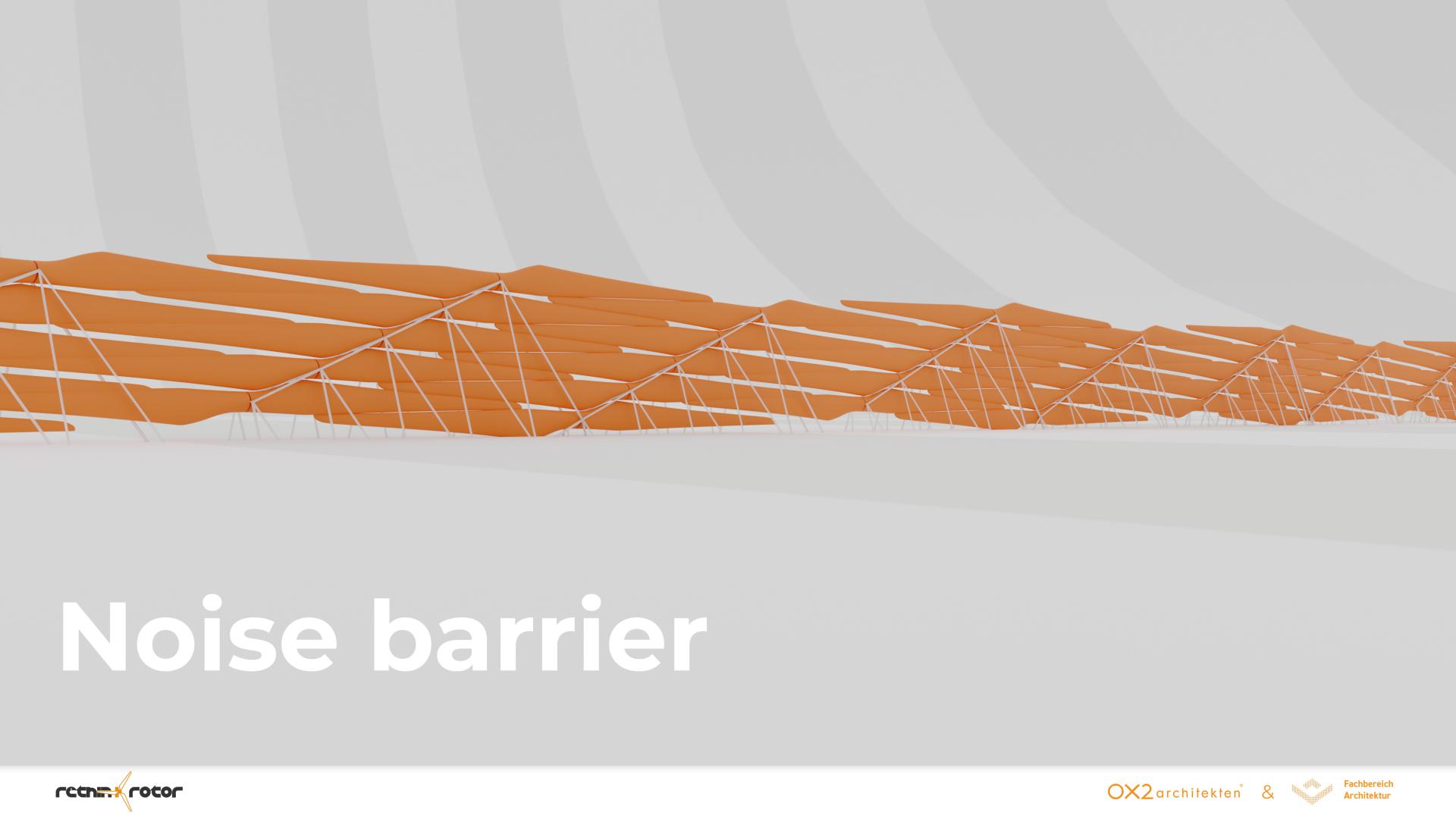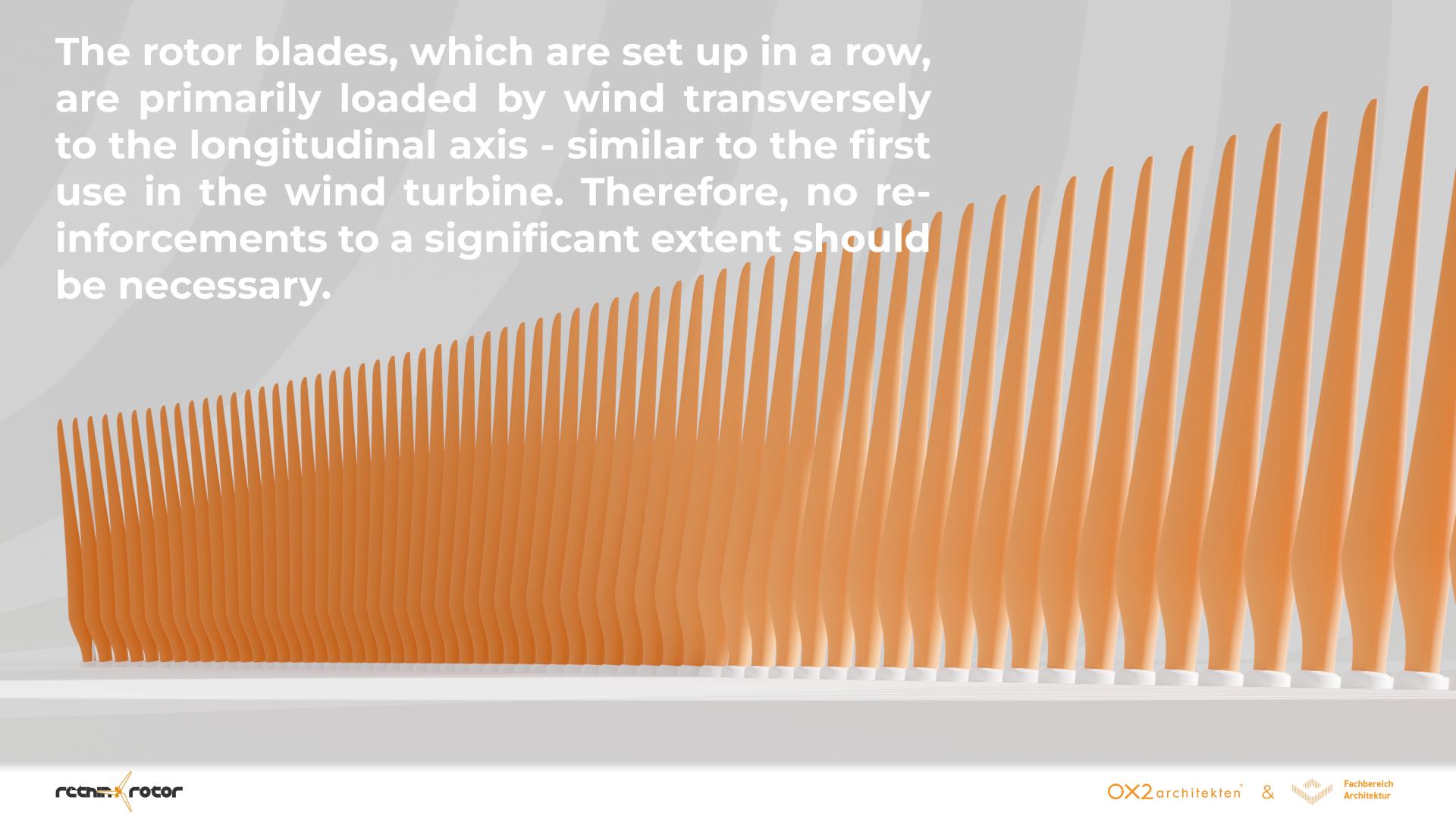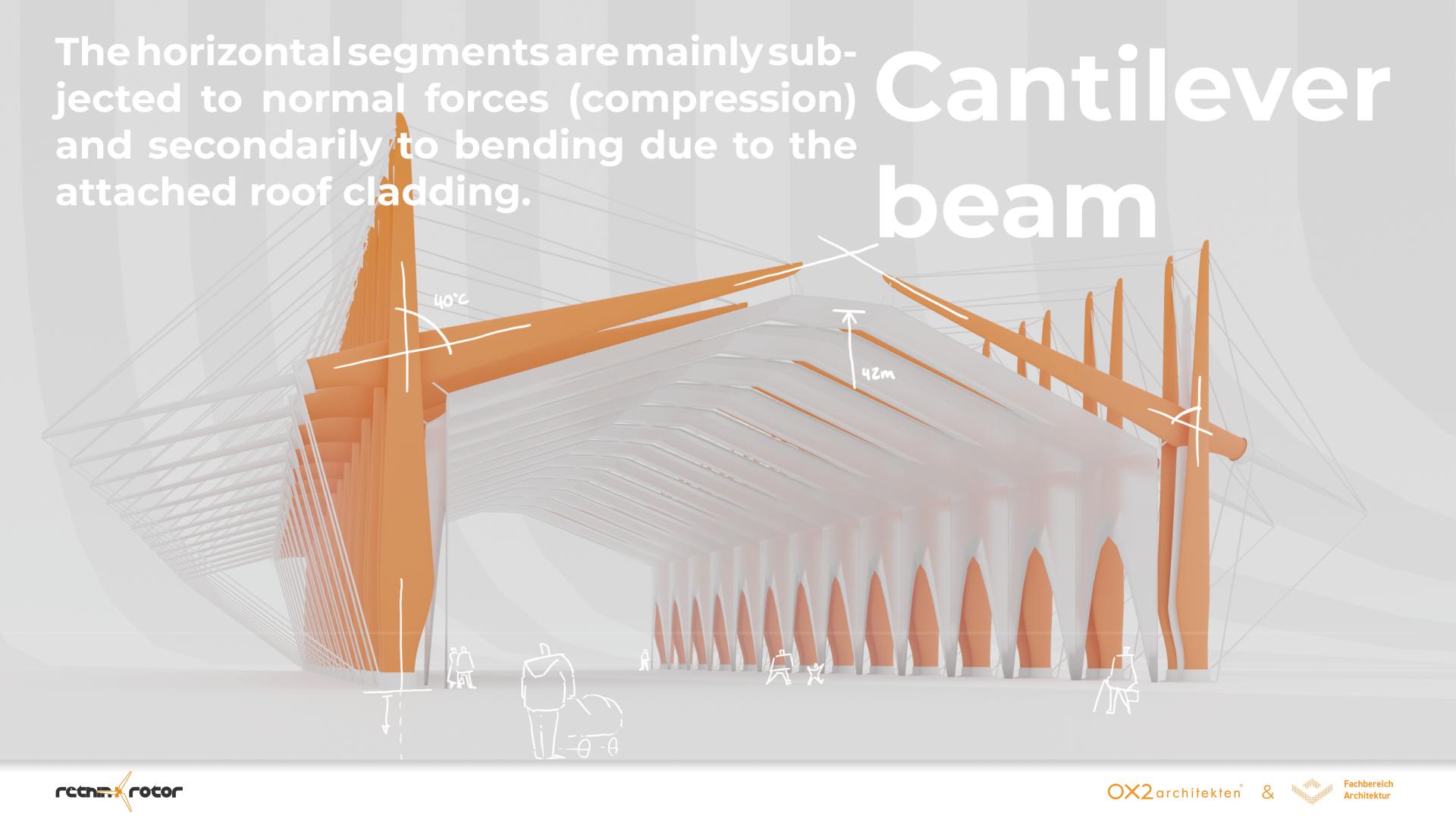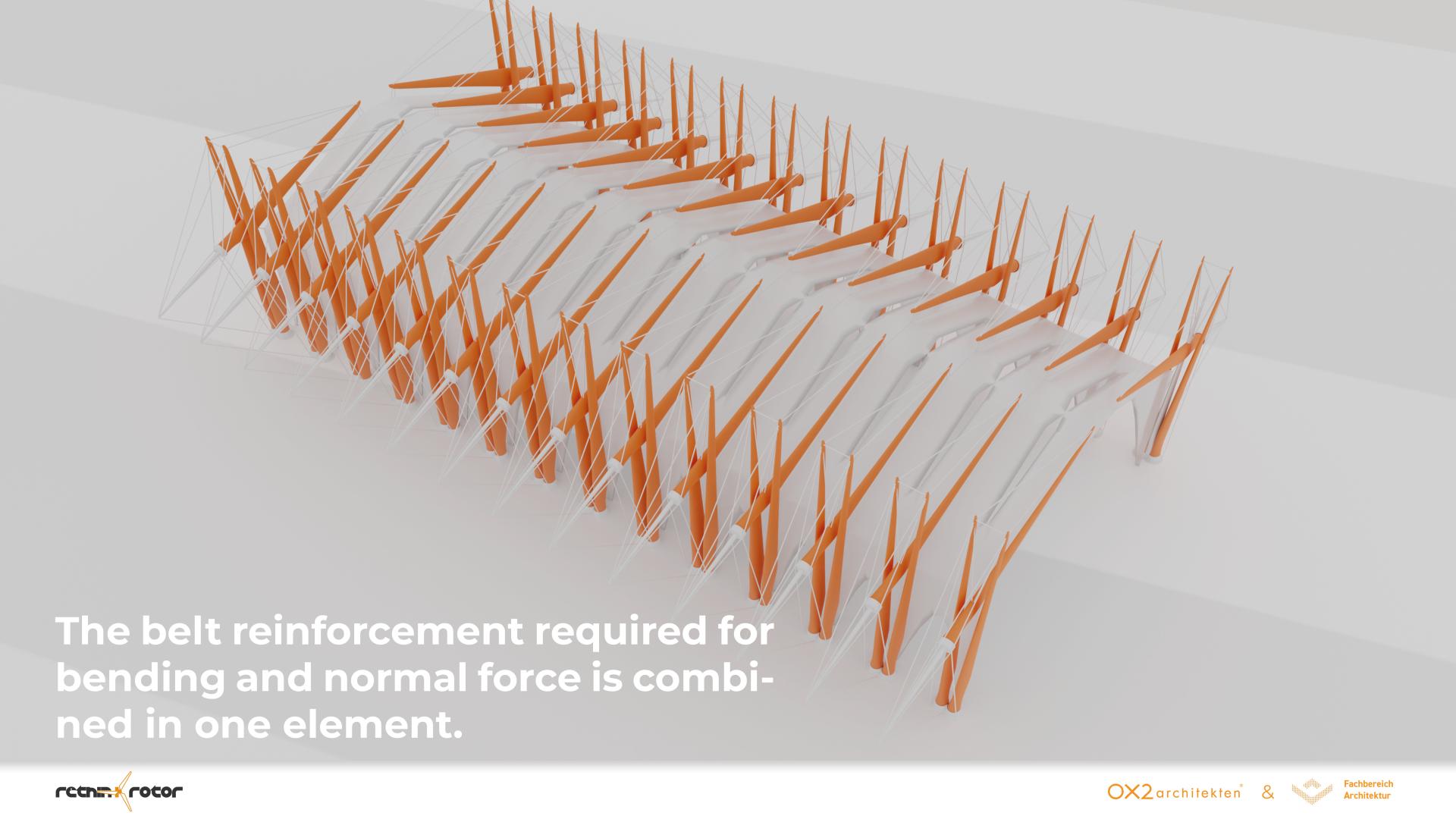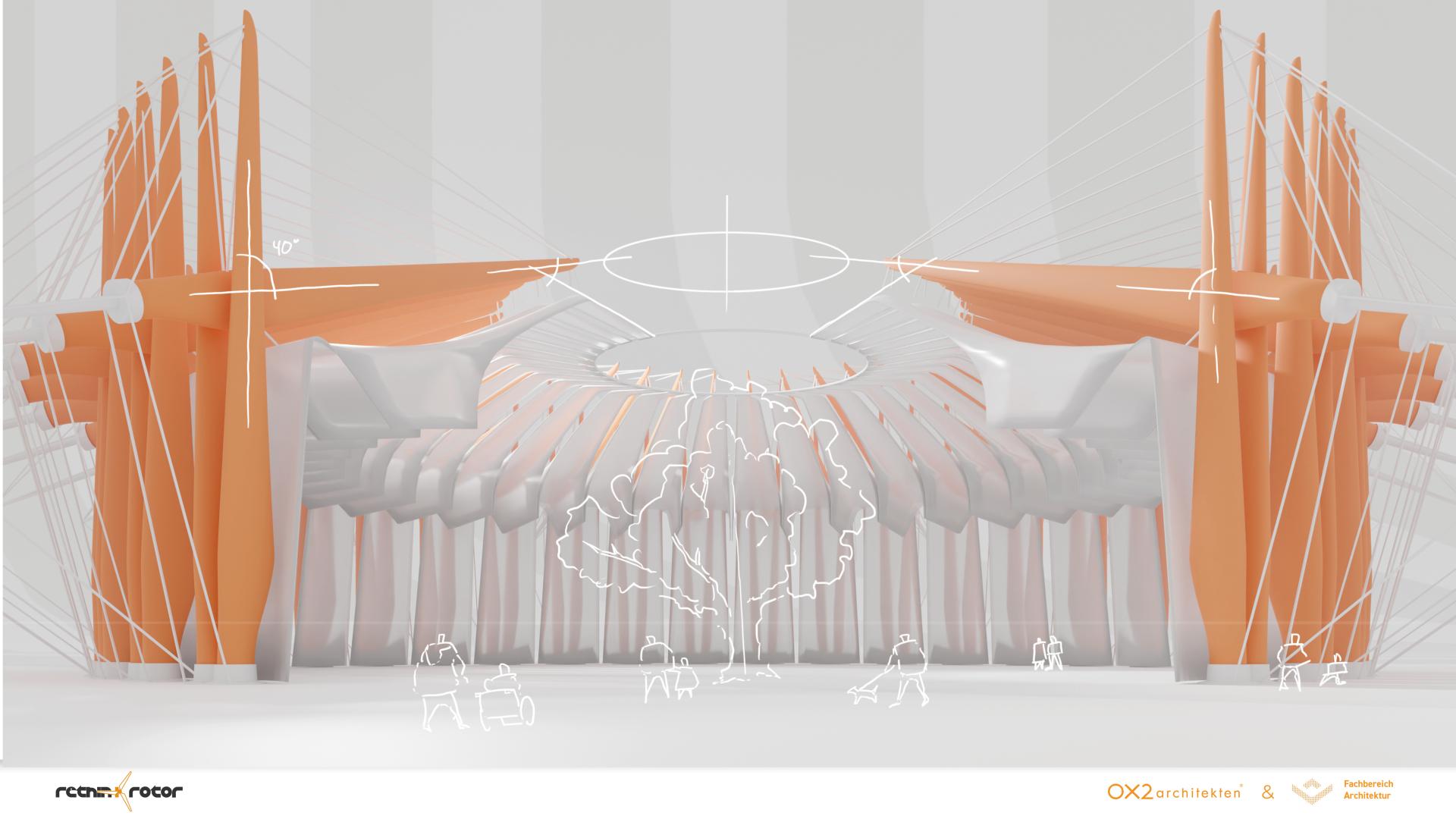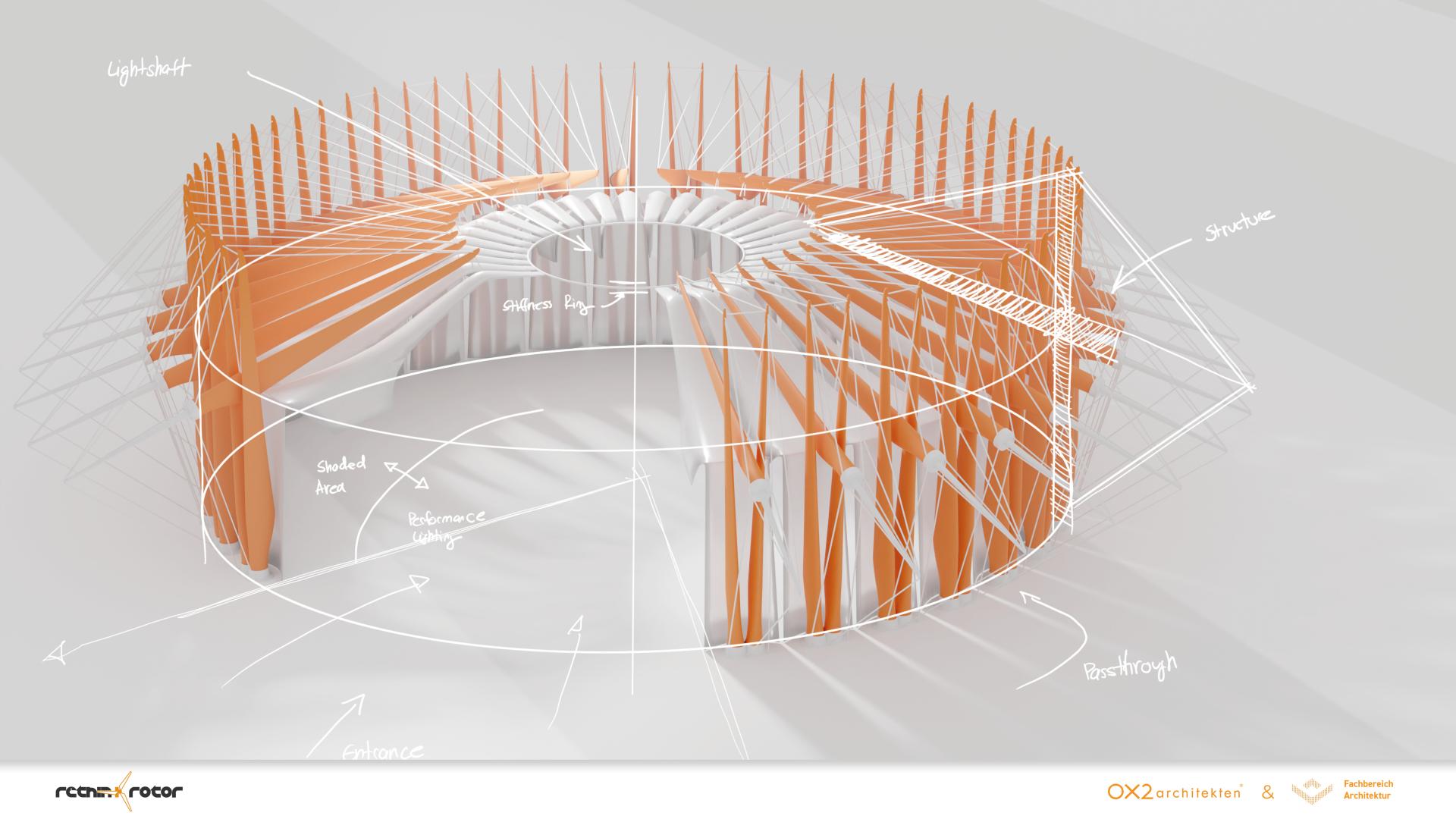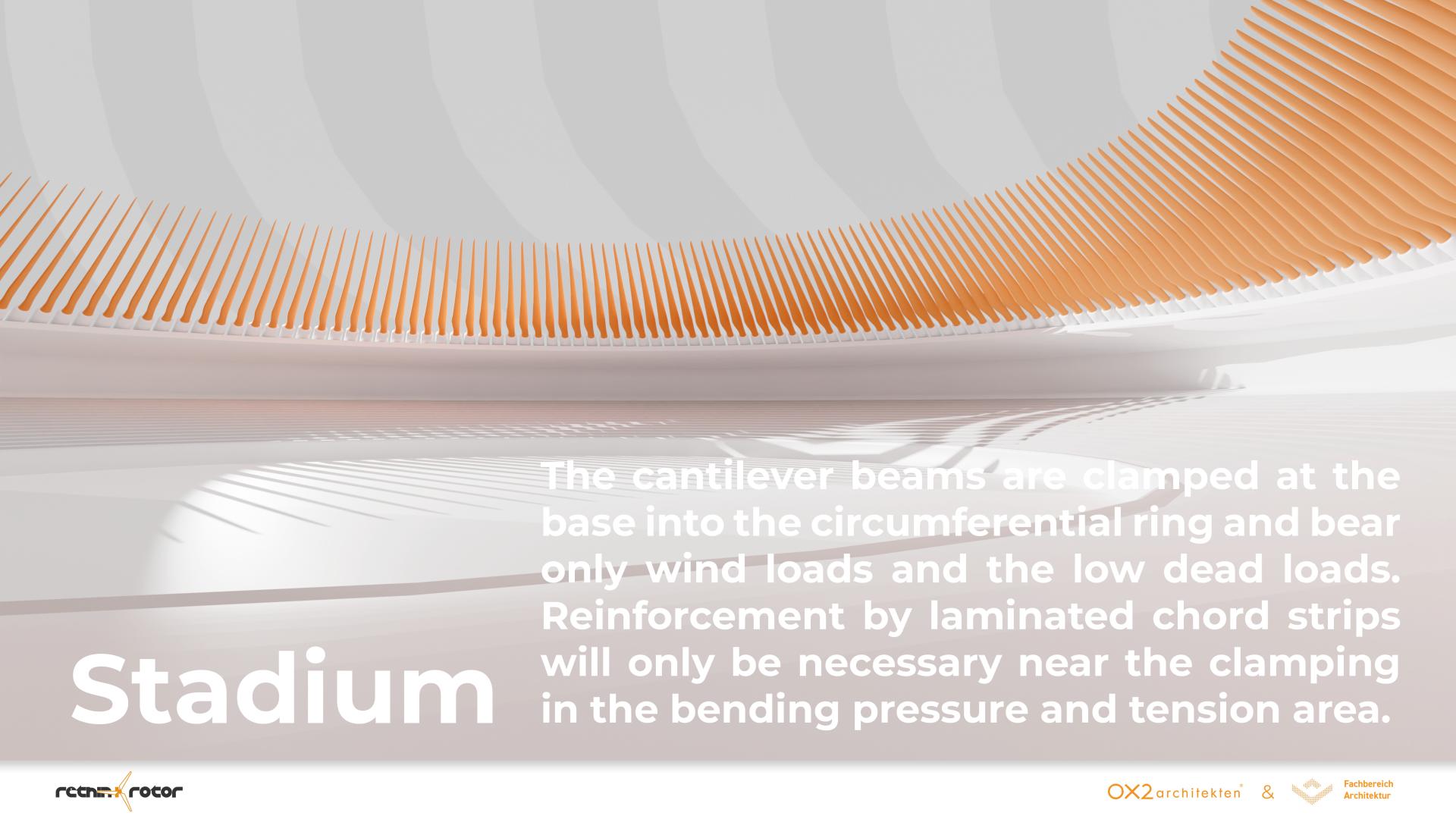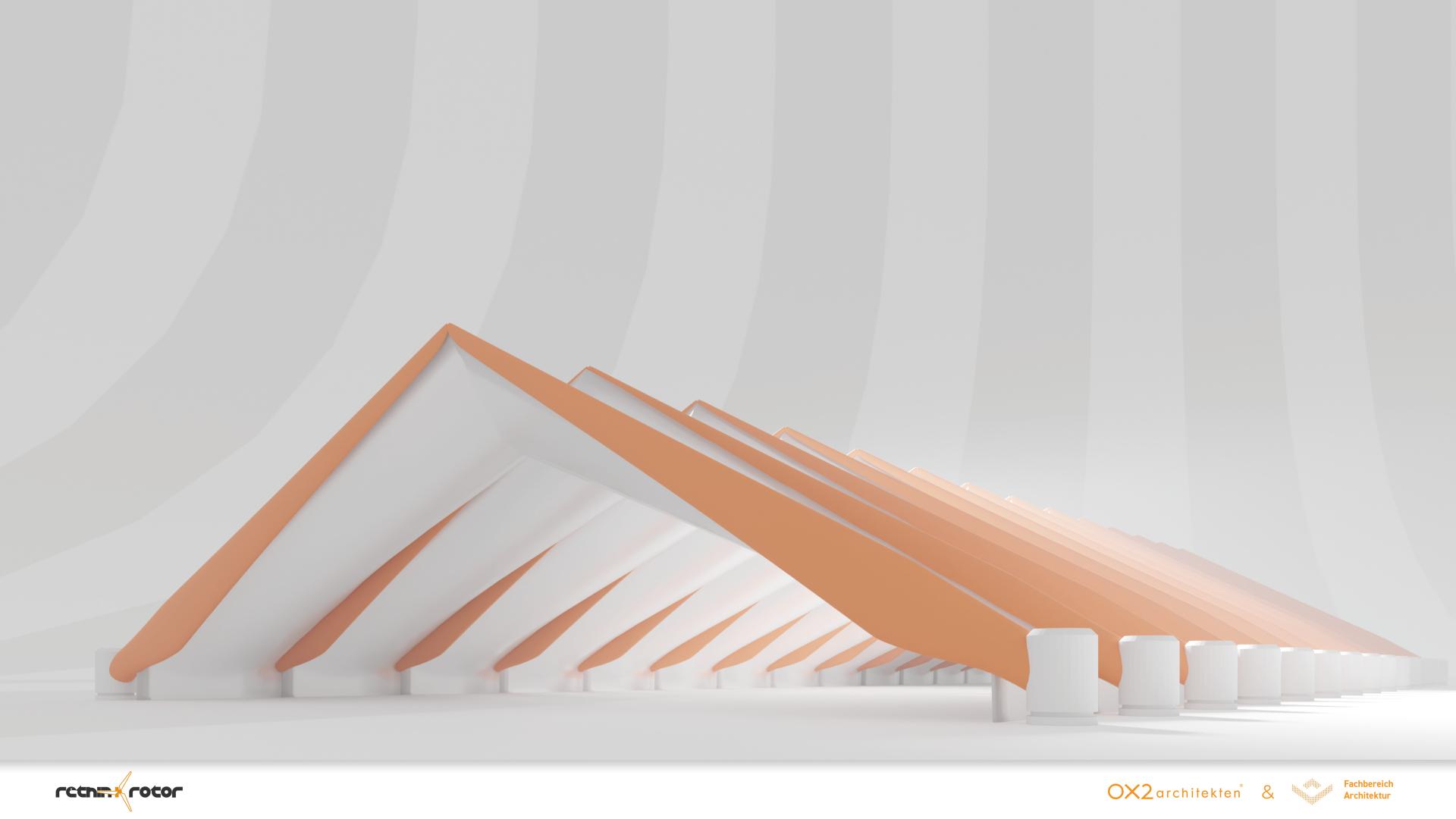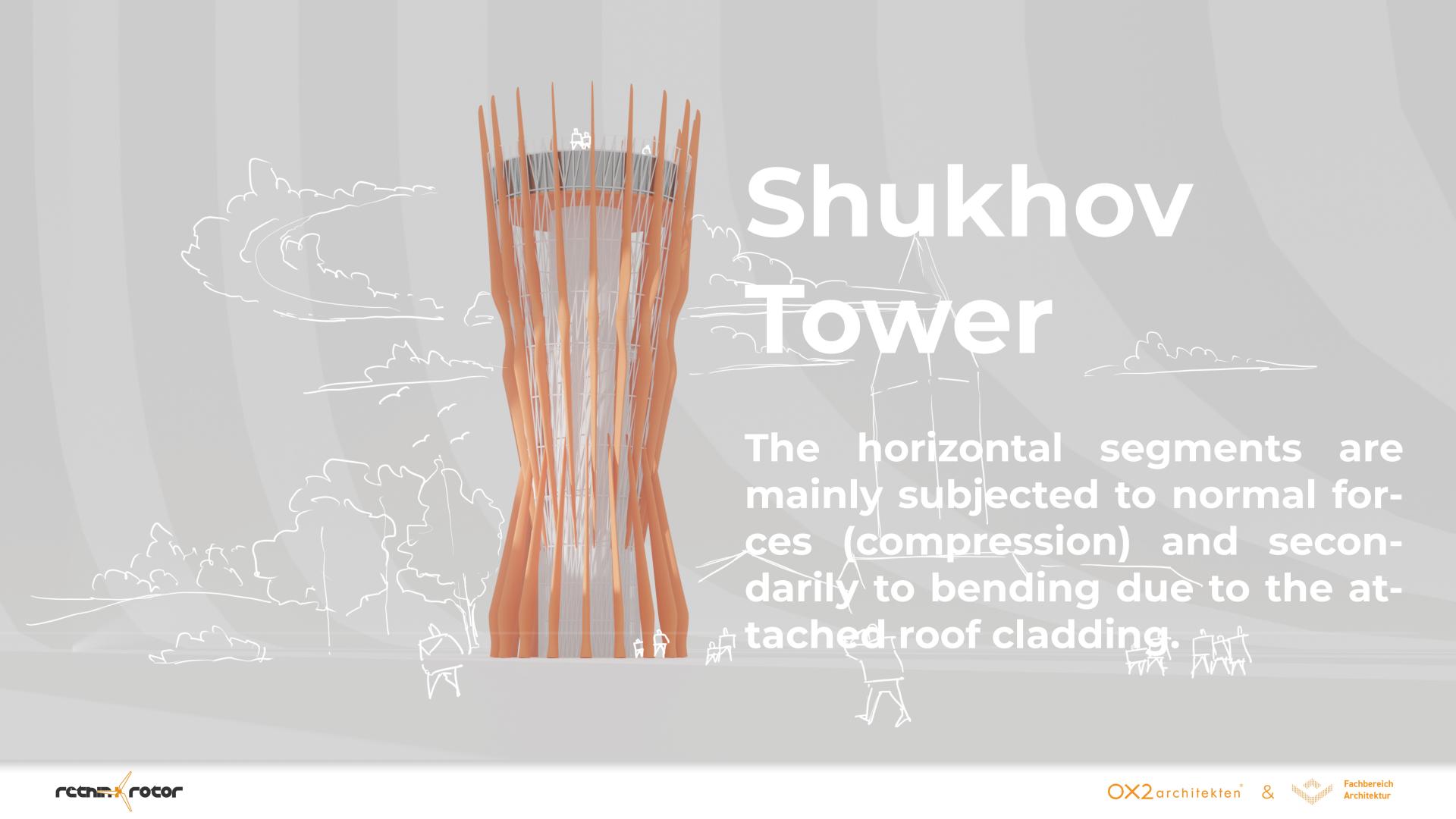Rethink Rotor
Basic information
Project Title
Rethink Rotor
Full project title
Rethink Rotor
Category
Shaping a circular industrial ecosystem and supporting life-cycle thinking
Project Description
Wind energy generates 21% of Germany's gross electricity, but what happens to the rotor blades after they are used? 7500 rotor blades are yearly disposed in Germany. Rethink Rotor is a collaborative project between Darmstadt University of Applied Sciences and OX2Architekten. The students from different departments have dealt with the topic of recycling rotor blades and thus created Rethink Rotor. Through the expertise of different fields we have found a functional way to reuse rotor blades.
Geographical Scope
Local
Project Region
Germany
Urban or rural issues
It addresses urban-rural linkages
Physical or other transformations
It refers to a physical transformation of the built environment (hard investment)
EU Programme or fund
No
Description of the project
Summary
Rethink*Rotor is a project investigating methods of reusing wind turbine rotor elements already on the market as a "second life application" in the construction sector. Thanks to the material properties such as durability, low weight and high stiffness, supported by the creative ideas within the project, it is likely that the large turbine components will remain in the anthroposphere. With around 21.7 % of gross electricity in Germany, wind energy is a rapidly growing market. As a result of the major restructuring of the German energy supply, 80 % of the electricity consumption, which will be significantly higher by then, is to be covered by renewable energies by 2030, instead of only about half so far - this will only be possible with a massive expansion of wind farms. However, the rotor blades of the wind turbines will have to be replaced after 20 years. Already now, about 7,500 of the parts are disposed of every year...
But what happens to the discarded, in some cases over 80 m long, custom-made parts made of epoxy resin-bonded fibre-reinforced plastics after they have been used in the wind farm for about 20 years?
Because of the high-performance material cocktail, which is made almost exclusively of duromers, the rotor blades can only be partially recycled by means of costly, environmentally harmful processes. Once cured, the epoxy resin-based plastic matrix of the huge blade surfaces can no longer be deformed. Some of them are therefore shredded after dismantling and the metal residues they contain are separated. The remaining waste is used thermally as a fuel and sand substitute in the cement industry or burnt in small quantities in conventional waste incineration plants. This form of thermal recycling is not residue-free, neither CO₂-neutral, nor sustainable, because recycling is accompanied by a loss of quality of the non-degradable materials, which still end up in the waste, thus reducing the overall sustainability of the wind turbines
But what happens to the discarded, in some cases over 80 m long, custom-made parts made of epoxy resin-bonded fibre-reinforced plastics after they have been used in the wind farm for about 20 years?
Because of the high-performance material cocktail, which is made almost exclusively of duromers, the rotor blades can only be partially recycled by means of costly, environmentally harmful processes. Once cured, the epoxy resin-based plastic matrix of the huge blade surfaces can no longer be deformed. Some of them are therefore shredded after dismantling and the metal residues they contain are separated. The remaining waste is used thermally as a fuel and sand substitute in the cement industry or burnt in small quantities in conventional waste incineration plants. This form of thermal recycling is not residue-free, neither CO₂-neutral, nor sustainable, because recycling is accompanied by a loss of quality of the non-degradable materials, which still end up in the waste, thus reducing the overall sustainability of the wind turbines
Key objectives for sustainability
Why does the use of rotor blades in the construction sector make sense?
The construction sector is responsible for about 40 % of greenhouse gas emissions worldwide.
In December 2015, at the World Climate Conference in Paris, a climate agreement pledged to curb climate change and transform the global economy in a climate-friendly way.
To achieve this goal, no more climate-damaging gases may be emitted in the second half of this century than are removed from the atmosphere by so-called carbon sinks, such as forests.
One of the most important principles for our handling of these findings is: the grey energy contained in every building but also in every manufactured part (e.g. rotor blade) is irretrievably lost if we do not reuse it. In order to reduce further exploitation of earth resources, the preservation or recycling of urban warehouses is an important economic goal.
For this reason, a team of experts has been working for some time within the framework of the Rethink*Rotor project to find ways to reuse discarded rotor blades in the construction industry - in the spirit of circularity.
The aim of Rethink*Rotor is to replace the current practice of recycling or final disposal with the reuse of the elements as building products and thus their remaining in the anthroposphere. For this purpose, the rotor blades are sorted according to shape and resilience and classified for usability in the construction sector.
The construction sector is responsible for about 40 % of greenhouse gas emissions worldwide.
In December 2015, at the World Climate Conference in Paris, a climate agreement pledged to curb climate change and transform the global economy in a climate-friendly way.
To achieve this goal, no more climate-damaging gases may be emitted in the second half of this century than are removed from the atmosphere by so-called carbon sinks, such as forests.
One of the most important principles for our handling of these findings is: the grey energy contained in every building but also in every manufactured part (e.g. rotor blade) is irretrievably lost if we do not reuse it. In order to reduce further exploitation of earth resources, the preservation or recycling of urban warehouses is an important economic goal.
For this reason, a team of experts has been working for some time within the framework of the Rethink*Rotor project to find ways to reuse discarded rotor blades in the construction industry - in the spirit of circularity.
The aim of Rethink*Rotor is to replace the current practice of recycling or final disposal with the reuse of the elements as building products and thus their remaining in the anthroposphere. For this purpose, the rotor blades are sorted according to shape and resilience and classified for usability in the construction sector.
Key objectives for aesthetics and quality
Rethink*Rotor provides high-quality yet simple solutions for the complex task of giving disused rotor blades a second life in the construction sector and integrating them into the architecture of buildings.
The "second life applications" of the complex geometries of the rotor blades are supported by the beauty of the parts, but in order to guarantee their use in new applications, a whole series of creative and constructive ideas are required. Only then can the aesthetic potential of the repaired, used and reclaimed be fully developed.
Another goal is to increase the acceptance of wind turbines. With this project, we see ourselves as part of the innovation front on the way to a building turnaround and sustainable change for the built world.
The challenge resulting from the complexity and long-lasting use of the parts once they have been produced, whether these are rotor blades or parts of a building, illustrates the urgency of solving the individual critical aspects. Without this, the vision of the building turnaround and the sustainable built world is only an illusion.
The "second life applications" of the complex geometries of the rotor blades are supported by the beauty of the parts, but in order to guarantee their use in new applications, a whole series of creative and constructive ideas are required. Only then can the aesthetic potential of the repaired, used and reclaimed be fully developed.
Another goal is to increase the acceptance of wind turbines. With this project, we see ourselves as part of the innovation front on the way to a building turnaround and sustainable change for the built world.
The challenge resulting from the complexity and long-lasting use of the parts once they have been produced, whether these are rotor blades or parts of a building, illustrates the urgency of solving the individual critical aspects. Without this, the vision of the building turnaround and the sustainable built world is only an illusion.
Key objectives for inclusion
With around 21.7 % of gross electricity in Germany, wind energy is a rapidly growing market. As a result of the major restructuring of the German energy supply, 80 % of the electricity consumption, which will be significantly higher by then, is to be covered by renewable energies by 2030, instead of only about half so far - this will only be possible with a massive expansion of wind farms.
In December 2015, at the World Climate Conference in Paris, a climate agreement pledged to curb climate change and transform the global economy in a climate-friendly way.
To achieve this goal, no more climate-damaging gases may be emitted in the second half of this century than are removed from the atmosphere by so-called carbon sinks, such as forests.
One possible way out of the recycling dilemma will be new Second Life applications, such as those being researched in the Rethink*Rotor project in the sense of cross-sector circularity, to then be used "profitably" in the construction sector.
Why does the use of rotor blades in the construction sector make sense?
The construction sector is responsible for about 40 % of greenhouse gas emissions worldwide.
In December 2015, at the World Climate Conference in Paris, a climate agreement pledged to curb climate change and transform the global economy in a climate-friendly way.
To achieve this goal, no more climate-damaging gases may be emitted in the second half of this century than are removed from the atmosphere by so-called carbon sinks, such as forests.
One possible way out of the recycling dilemma will be new Second Life applications, such as those being researched in the Rethink*Rotor project in the sense of cross-sector circularity, to then be used "profitably" in the construction sector.
Why does the use of rotor blades in the construction sector make sense?
The construction sector is responsible for about 40 % of greenhouse gas emissions worldwide.
Results in relation to category
-
How Citizens benefit
Thanks to the material properties such as durability, corrosion resistance, low weight and high stiffness, supported by the creative ideas within the project, it is likely that the large turbine components will remain in the anthroposphere.
The aim of Rethink*Rotor is to replace the current practice of recycling or final disposal with the reuse of the elements as building products and thus their remaining in the anthroposphere. For this purpose, the rotor blades are sorted according to shape and resilience and classified for usability in the construction sector.
One of the most important principles for our handling of these findings is: the grey energy contained in every building but also in every manufactured part (e.g. rotor blade) is irretrievably lost if we do not reuse it. In order to reduce further exploitation of earth resources, the preservation or recycling of urban warehouses is an important economic goal.
For this reason, a team of experts has been working for some time within the framework of the Rethink*Rotor project to find ways to reuse discarded rotor blades in the construction industry - in the spirit of circularity.
The aim of Rethink*Rotor is to replace the current practice of recycling or final disposal with the reuse of the elements as building products and thus their remaining in the anthroposphere. For this purpose, the rotor blades are sorted according to shape and resilience and classified for usability in the construction sector.
One of the most important principles for our handling of these findings is: the grey energy contained in every building but also in every manufactured part (e.g. rotor blade) is irretrievably lost if we do not reuse it. In order to reduce further exploitation of earth resources, the preservation or recycling of urban warehouses is an important economic goal.
For this reason, a team of experts has been working for some time within the framework of the Rethink*Rotor project to find ways to reuse discarded rotor blades in the construction industry - in the spirit of circularity.
Physical or other transformations
It refers to a physical transformation of the built environment (hard investment)
Innovative character
Building with rotor blades was unthinkable until now, because the sizes involved are enormous. However, this is exactly our goal, we want to think bigger and thus counteract the recycling problem. If in Germany alone 7500 rotor blades are disposed of annually, we would like to create a way to counteract this dilemma.
Disciplines/knowledge reflected
The project was launched with many people from different fields of work. Since we are a cooperative project with students from different departments, we were able to draw on the knowledge of a wide variety of directions. This resulted in a project that was designed by architects, constructed by civil engineers and tested by plastics engineers.
Methodology used
We are currently presenting our project at various events to publicize the topic.
How stakeholders are engaged
We are a cooperation between the University of Applied Science and OX2Architekten. Therefore we are our own stakeholder. However, we are currently in contact with various production companies to start a mutual exchange.
Global challenges
Rethink*Rotor is a project investigating methods of reusing wind turbine rotor elements already on the market as a "second life application" in the construction sector. However, the rotor blades of the wind turbines will have to be replaced after 20 years. Already now, about 7,500 of the parts are disposed of every year...
But what happens to the discarded, in some cases over 80 m long, custom-made parts made of epoxy resin-bonded fibre-reinforced plastics (FRP) after they have been used in the wind farm for about 20 years?
Because of the high-performance material cocktail, which is made almost exclusively of duromers, the rotor blades can only be partially recycled by means of costly, environmentally harmful processes. Some of them are therefore shredded after dismantling and the metal residues they contain are separated. The remaining waste is used thermally as a fuel and sand substitute in the cement industry or burnt in small quantities in conventional waste incineration plants. This form of thermal recycling is not residue-free, neither CO₂-neutral, nor sustainable, because recycling is accompanied by a loss of quality of the non-degradable materials, which still end up in the waste.
But what happens to the discarded, in some cases over 80 m long, custom-made parts made of epoxy resin-bonded fibre-reinforced plastics (FRP) after they have been used in the wind farm for about 20 years?
Because of the high-performance material cocktail, which is made almost exclusively of duromers, the rotor blades can only be partially recycled by means of costly, environmentally harmful processes. Some of them are therefore shredded after dismantling and the metal residues they contain are separated. The remaining waste is used thermally as a fuel and sand substitute in the cement industry or burnt in small quantities in conventional waste incineration plants. This form of thermal recycling is not residue-free, neither CO₂-neutral, nor sustainable, because recycling is accompanied by a loss of quality of the non-degradable materials, which still end up in the waste.
Learning transferred to other parties
As already mentioned, about 7,500 of the rotor blades are currently disposed of as waste in Germany every year. In the near future, a much larger number can be expected.
For this reason, the Rethink*Rotor project focuses on a broad spectrum of possible new applications for rotor blades in the building sector. Starting with 30 to 60 pieces for an industrial hall or 600 for a noise barrier up to 2000 or more for a pontoon construction as a floating support structure for a floating village. These are only three selected examples of the many topics that the Rethink*Rotor project deals with. An important aspect is to find a secondary use near the original location of the wind turbine in order to minimise transport distances. To this end, work is also being done on processing concepts that make it possible to implement them on site. One of the prerequisites is that the joints for the components can be realised with low-tach methods.
Thanks to the prospects for subsequent use of the rotor blades, the acceptance of wind turbines in an urban context is also increased.
For this reason, the Rethink*Rotor project focuses on a broad spectrum of possible new applications for rotor blades in the building sector. Starting with 30 to 60 pieces for an industrial hall or 600 for a noise barrier up to 2000 or more for a pontoon construction as a floating support structure for a floating village. These are only three selected examples of the many topics that the Rethink*Rotor project deals with. An important aspect is to find a secondary use near the original location of the wind turbine in order to minimise transport distances. To this end, work is also being done on processing concepts that make it possible to implement them on site. One of the prerequisites is that the joints for the components can be realised with low-tach methods.
Thanks to the prospects for subsequent use of the rotor blades, the acceptance of wind turbines in an urban context is also increased.
Keywords
circularity
reuse
futuristic way to build
cooperation between Unerversity of Applied Science and OX2Architekten
wind energie

